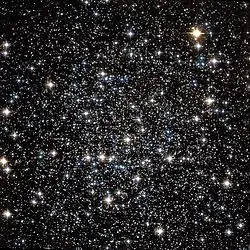NGC 288
NGC 288 is a globular cluster in the constellation Sculptor. Its visual appearance was described by John Dreyer in 1888.[7] It is located about 1.8° southeast of the galaxy NGC 253, 37′ north-northeast of the South Galactic Pole, 15′ south-southeast of a 9th magnitude star, and encompassed by a half-circular chain of stars that opens on its southwest side.[1] It can be observed through binoculars.[1] It is not very concentrated and has a well resolved, large 3′ dense core that is surrounded by a much more diffuse and irregular 9′ diameter ring.[1] Peripheral members extend farther outward towards the south and especially southwest.[1]
| NGC 288 | |
|---|---|
 NGC 288 by Hubble Space Telescope's Wide Field Channel of the Advanced Camera for Surveys Credit: ESA/Hubble & NASA | |
| Observation data (J2000 epoch) | |
| Class | X[1] |
| Constellation | Sculptor |
| Right ascension | 00h 52m 45.24s[2] |
| Declination | –26° 34′ 57.4″[2] |
| Distance | 28.7 kly (8.8 kpc)[3] |
| Apparent magnitude (V) | 9.37[4] |
| Apparent dimensions (V) | 13′.8[1] |
| Physical characteristics | |
| Mass | 4.8×104[5] M☉ |
| Metallicity | = –1.14[6] dex |
| Estimated age | 10.62 Gyr[6] |
| Other designations | Melotte 3[4] |
References
- Kepple, George Robert; Sanner, Glen W. (1998). The Night Sky Observer's Guide. 2. Willmann-Bell, Inc. pp. 365, 372. ISBN 978-0-943396-60-6.
- Goldsbury, Ryan; et al. (December 2010), "The ACS Survey of Galactic Globular Clusters. X. New Determinations of Centers for 65 Clusters", The Astronomical Journal, 140 (6): 1830–1837, arXiv:1008.2755, Bibcode:2010AJ....140.1830G, doi:10.1088/0004-6256/140/6/1830.
- Paust, Nathaniel E. Q.; et al. (February 2010), "The ACS Survey of Galactic Globular Clusters. VIII. Effects of Environment on Globular Cluster Global Mass Functions", The Astronomical Journal, 139 (2): 476–491, Bibcode:2010AJ....139..476P, doi:10.1088/0004-6256/139/2/476, hdl:2152/34371
- "NGC 288". SIMBAD. Centre de données astronomiques de Strasbourg. Retrieved 2007-02-10.
- Marks, Michael; Kroupa, Pavel (August 2010), "Initial conditions for globular clusters and assembly of the old globular cluster population of the Milky Way", Monthly Notices of the Royal Astronomical Society, 406 (3): 2000–2012, arXiv:1004.2255, Bibcode:2010MNRAS.406.2000M, doi:10.1111/j.1365-2966.2010.16813.x. Mass is from MPD on Table 1.
- Forbes, Duncan A.; Bridges, Terry (May 2010), "Accreted versus in situ Milky Way globular clusters", Monthly Notices of the Royal Astronomical Society, 404 (3): 1203–1214, arXiv:1001.4289, Bibcode:2010MNRAS.404.1203F, doi:10.1111/j.1365-2966.2010.16373.x.
- Dreyer, J. L. E. (1888). "A New General Catalogue of Nebulae and Clusters of Stars, being the Catalogue of the late Sir John F. W. Herschel, Bart., revised, corrected, and enlarged". Memoirs of the Royal Astronomical Society. 49: 1–237. Bibcode:1888MmRAS..49....1D.
External links
 Media related to NGC 288 at Wikimedia Commons
Media related to NGC 288 at Wikimedia Commons- Frommert, Harmut. "Revised NGC Data for NGC 288". Spider. Students for the Exploration and Development of Space.
- NGC 288 on WikiSky: DSS2, SDSS, GALEX, IRAS, Hydrogen α, X-Ray, Astrophoto, Sky Map, Articles and images
This article is issued from Wikipedia. The text is licensed under Creative Commons - Attribution - Sharealike. Additional terms may apply for the media files.